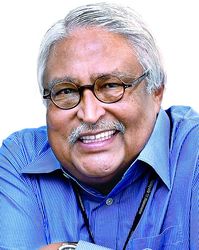
LAST YEAR, after Britain chose to walk away from the European Union, the foreign office in London was in complete chaos. One of its immediate reactions, aimed at assuaging Europe's concerns over Brexit, was to send William, the duke of Cambridge, to Germany. William, the second in line to the British throne, charmed the Germans, and assured Chancellor Angela Merkel that Britain's friendship with Germany would not change even after Brexit. German and British media hailed the royal visit as a “rescue mission” to shore up Anglo-German ties.
The royals, indeed, have a charm of their own. Don't get me wrong, I am a firm believer in democracy. My family and our newspaper, the Malayala Manorama, were in the forefront of the freedom movement. My grandfather K.C. Mammen Mappillai staunchly opposed the dictatorial tendencies of C.P. Ramaswami Aiyar, the diwan [prime minister] of the Travancore royal family. After Manorama reported how Aiyar's police killed people agitating for civil rights, the vengeful diwan shut down the newspaper and jailed my grandfather.
I must, however, confess that I still remain fascinated by the royals: their tastes, their eccentricities, and more interestingly, how they have changed and adapted to a world that swears increasingly by democracy.
Our Independence Day Special Issue attempts to find answers to such questions about our own royals. As our Special Correspondent Cithara Paul observes in her opening essay, when India became independent, the nation was a mishmash of 565 princely states. Some of our rulers were gentle, some others cruel; some were erudite, and a few silly. Some were unbelievably rich, and some, unimaginably poor. Some ruled over vast territories—both Kashmir and Hyderabad were spread over more than two lakh square kilometres—while some owned barely a few acres. It was a curious mix.
Our story looks at the contemporary lives of nine of the prominent royal families: Baroda, Kashmir, Mewar, Kolhapur, Travancore, Hyderabad, Mysore, the Scindias and the Holkars. Our correspondents look at how these royal houses fare after 70 years of independence. What are they doing? How do they manage their assets? Which legal battles do they continue to fight? What are their pet projects? And, how have been their trysts with politics, sports, arts and business?
We also have three royals—Tikka Shatrujit Singh of Kapurthala, Yajurvindra Singh of Bilkha and Saad Bin Jung of Pataudi—sharing their views and experiences with THE WEEK. In his piece, Yajurvindra Singh shares an anecdote involving his family's Phantom III Rolls-Royce. Once the car hit a young man, Karsan Ghavri, who was on a bicycle. The cycle was badly damaged. Yajurvindra's grandfather found out that Ghavri was a budding cricketer and promptly sent him a brand new bicycle and a cricket bat, along with a warning never to come in front of the Phantom again. Ghavri later played for India.
The Travancore royals are a study in contrast. The vaults of the Sri Padmanabhaswamy temple might be a treasure trove, but the kings of Travancore have always stayed true to their legacy of simplicity. It was Sree Moolam Tirunal, the maharajah of Travancore from 1885 to 1924, who gave Malayala Manorama his royal coat of arms. With a slight modification, it continues to adorn our logo, even after a century.





